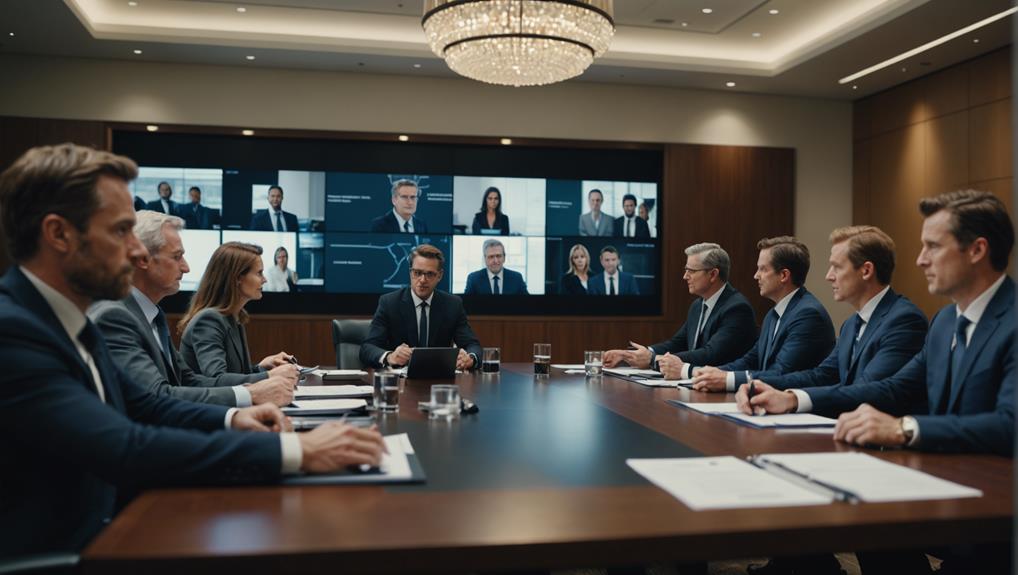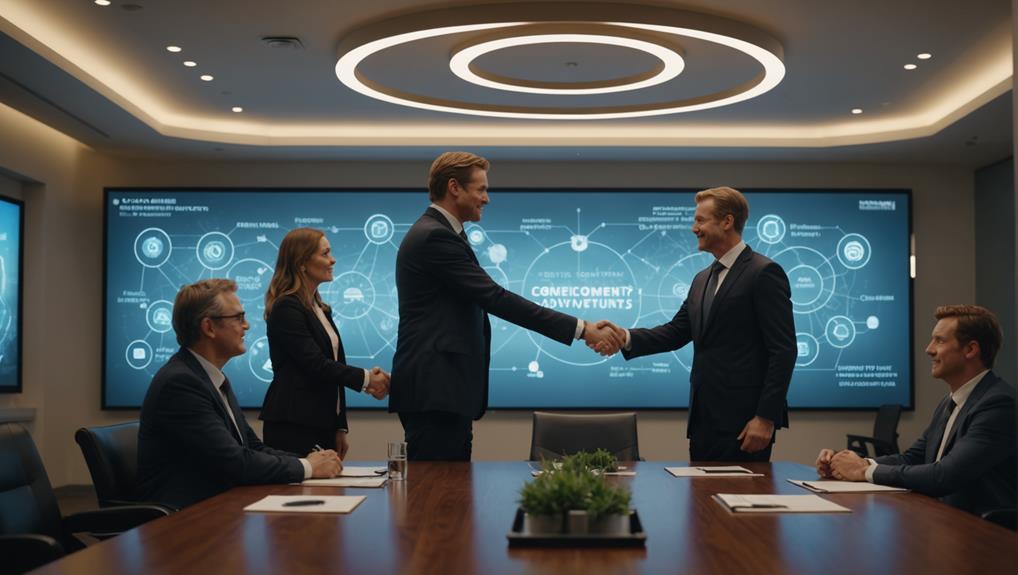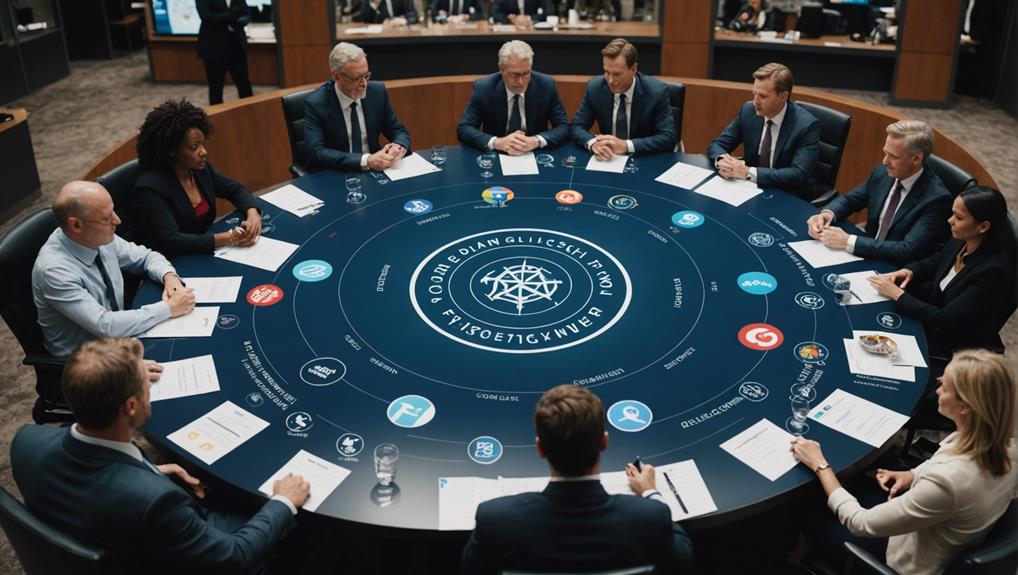The Role of Leadership in Mergers and Acquisitions

In mergers and acquisitions, robust leadership plays a crucial role in guiding the integration process and aligning organizational values. Leaders have the task of molding the post-merger culture, ensuring a seamless transition through clear communication and fostering a shared vision.
Their responsibilities include managing cultural differences, sustaining employee engagement, and encouraging innovation. Effective leadership acts as a bridge, harmonizing diverse teams and setting a unified direction. Through strategic alignment and transparent communication, leaders boost performance and instill trust across the organization.
Understanding the pivotal role of leadership in M&As can help navigate successful integrations and drive sustainable growth. Explore the nuances of effective M&A leadership further.
Key Takeaways
- Resolute leadership plays a pivotal role in guiding the seamless integration of companies during mergers and acquisitions, shaping the organizational culture in the post-merger phase.
- Open and consistent communication led by executives is key to fostering employee support and engagement throughout the merger process.
- Effective leadership acts as a bridge across cultural differences, enhancing cohesion and unity within the newly integrated organization.
- Leaders who align organizational values post-merger are instrumental in creating a unified corporate culture that supports the shared vision of the combined entity.
- Forward-thinking leadership not only promotes innovation but also ensures strategic alignment at every stage of the M&A process.
M&A Trends and Challenges
Mergers and acquisitions have seen a global upsurge, reaching a remarkable US$4 trillion in 2006, with a continuing trend towards increasing complexity and challenges. As organizations enhance their merger management skills, the volume of deals is expected to rise. The U.S. remains the primary target for acquisitions, with Europe closely following, boasting deals valued at a substantial US$1.4 trillion in 2006. This surge marks a pivotal moment in the business landscape, underscoring the crucial role of leadership.
The merger process entails profound transformational change, often leading to disruptions. The integration of procedures, values, and cultures from disparate organizations is a complex endeavor. Effective leadership is paramount in strategically managing these changes to ensure seamless transitions and favorable outcomes. Successful mergers and acquisitions are contingent on aligning leadership actions across diverse national, organizational, and individual contexts.
In this dynamic landscape, innovative thinking is indispensable. Leaders must embrace change and cultivate an adaptable mindset within their teams. The adept management of these complexities can significantly impact the success of a merger.
Importance of Leadership in M&As
In the realm of mergers and acquisitions, strong leadership plays a crucial role in guiding organizations through the intricate process of integration. Our leadership abilities are essential in ensuring a smooth and successful post-merger transition. Exceptional leaders shape the newly formed organizational culture and drive employee engagement, fostering an environment conducive to innovation.
It is imperative to align our strategies and establish a shared vision that resonates with all stakeholders. This fosters a sense of commitment and purpose, which is vital for navigating the complexities of M&As. Leadership visibility, effective communication, and decisive actions are key to gaining employee support. When employees witness their leaders actively participating and being transparent about the integration process, they're more likely to feel valued and engaged.
Furthermore, the capacity to adapt and respond flexibly to challenges during integration is paramount. Through effective leadership, we can blend diverse organizational cultures and create a cohesive, forward-thinking entity.
Ultimately, strong leadership not only guides the organization through change but also paves the way for sustained innovation and growth in the newly unified company.
Leadership's Impact on Culture

Leadership significantly influences the culture during mergers and acquisitions. It's crucial to ensure that organizational values are aligned, cultural differences are managed effectively, and employee engagement is fostered to facilitate a seamless transition. Capable leaders are instrumental in integrating diverse cultures and driving shared success.
Leaders must navigate the complexities of merging different organizational cultures to create a cohesive and unified entity. By actively promoting collaboration, communication, and mutual understanding, leaders can mitigate potential challenges and build a strong foundation for the newly merged company.
Research has shown that companies with strong leadership alignment during mergers and acquisitions are more likely to achieve successful integration and long-term growth. By prioritizing cultural integration and employee engagement, leaders can create a positive and productive work environment that supports the overall success of the merger or acquisition.
Aligning Organizational Values
Being a successful leader plays a crucial role in aligning the core values of organizations and ensuring a seamless cultural integration during mergers and acquisitions. The leadership team needs to proactively shape the new corporate culture by implementing effective strategies that blend values, beliefs, and behaviors across the merged entities. Communication and modeling of desired values are key elements in setting a standard for all employees to embrace.
A unified corporate culture is essential for boosting employee engagement and retention, directly impacting the overall success of the merger. Leaders must take intentional steps to oversee this integration process, ensuring that every individual feels like an integral part of a cohesive and efficient work environment. This fosters a sense of belonging and dedication, which are vital for sustained success.
The significance of leading by example can't be underestimated. Consistent demonstration of the desired values by the leadership team creates a ripple effect throughout the organization, facilitating a smoother merger and enhancing trust and unity among employees.
Aligning organizational values through effective leadership isn't just about managing change; it's about sparking innovation and steering the future prosperity of the combined entity.
Navigating Cultural Differences
Cultural differences pose a challenge in mergers and acquisitions, but effective leadership can bridge these gaps and cultivate a cohesive organizational culture. It's essential to recognize that national cultural variations in global M&As necessitate intentional and considerate actions. Leaders play a crucial role in harmonizing the cultures of merging entities, ensuring that the blend of diverse backgrounds enhances rather than hinders our collective journey.
Leadership should prioritize achieving mutual adjustments and acculturation, moving beyond mere tolerance to embracing diversity and creating an inclusive environment where every team member feels valued and understood. Transparent communication, empathy, and shared objectives can help dismantle cultural barriers.
Effective leadership in cultural integration involves open communication, which fosters trust; inclusive decision-making, encouraging collaboration; cultural training, enhancing understanding; and a shared vision, aligning objectives. Through these actions, leaders can navigate and leverage cultural differences to strengthen the merged entity and drive success in mergers and acquisitions.
Fostering Employee Engagement
Employee engagement plays a pivotal role in shaping the organizational culture during mergers and acquisitions. Leaders must understand that their actions directly impact employee motivation, commitment, and adaptability. Engaged employees are more likely to support the integration process, embrace change, and contribute positively to the new organization.
To nurture engagement, a focus on communication and transparency is crucial. Keeping employees informed and involved helps alleviate uncertainties and fosters trust within the team. Investing in the development of employees is equally vital. Providing growth opportunities not only boosts morale but also ensures that the workforce is prepared to navigate the complexities of mergers and acquisitions.
Research highlights the significance of strong leadership in these circumstances. Effective leaders who prioritize employee engagement can lead to increased satisfaction, higher retention rates, and overall success in cultural integration endeavors. This involves creating a compelling vision that employees can align with and offering the necessary tools and support for their success.
Aligning Leadership and Strategy
Aligning leadership and strategy plays a pivotal role in guiding mergers and acquisitions towards successful outcomes. It is essential to understand that effective leadership serves as the foundation for this synchronization. Leaders must ensure that the strategic vision of the merged entity is clearly communicated, laying the groundwork for a seamless integration process.
Leadership involves overseeing the integration process, fostering a collaborative culture, and managing the inevitable changes that accompany mergers and acquisitions. To accomplish this, robust strategies for change management should be implemented, creating alignment between leadership and strategy. This alignment not only increases employee engagement but also enhances overall performance, ensuring that everyone is working towards the same objectives.
Key Elements:
| Element | Leadership Role | Strategic Impact |
|---|---|---|
| Vision Communication | Transparent and clear | Establishing unified direction |
| Integration Guidance | Supportive and hands-on | Ensuring smooth progression |
| Culture of Collaboration | Promoting teamwork | Strengthening organizational cohesion |
| Change Management Strategies | Proactive and adaptive | Minimizing resistance to change |
| Strategic Alignment | Aligned with overarching goals | Improving performance and engagement |
Effective Communication Strategies

To ensure a successful merger, we must establish a clear strategic direction, provide regular updates on our progress, and consistently communicate our overarching vision. These actions will help us unite our teams, minimize uncertainty, and cultivate a harmonious work environment.
Effective communication serves as the foundation for guiding our employees through the intricacies of change and strengthening their involvement and confidence in the process.
Clear Strategic Intent
In mergers and acquisitions, it's crucial to clearly convey the strategic intent to ensure everyone comprehends the vision and objectives. By outlining a precise vision, we provide a roadmap that unites teams and steers them towards a common goal. Effective communication of these objectives is essential for all stakeholders to understand the purpose behind the merger or acquisition and their respective roles in it.
Ambiguous communication can lead to uncertainty and resistance, potentially derailing the integration process. Ensuring transparent and consistent communication is vital. Establishing specific, measurable, and action-oriented goals creates a framework that facilitates tracking progress and attaining desired outcomes. This approach fosters trust and commitment among employees, which are key to achieving success.
Emphasizing the long-term vision in our communication strategy helps employees see beyond immediate changes. This not only reduces resistance but also stimulates innovation, as teams feel more empowered to contribute their ideas. Effective communication goes beyond just relaying information; it aims to inspire and engage all involved parties, ensuring our collective efforts result in a seamless and prosperous integration.
Transparent Progress Updates
Keeping everyone informed and engaged throughout the merger process is crucial. Clear progress updates can greatly improve employee morale and reduce uncertainty during significant organizational changes. Regular communication on merger status and milestones fosters trust and alignment within our teams, ensuring that everyone is on the same page and working towards common goals.
To enhance our communication approach, we should consider the following strategies:
- Openly share key information: Keep employees informed about important developments and decisions.
- Address concerns promptly: Respond to employee questions and worries in a timely manner.
- Utilize multiple channels: Use emails, meetings, and intranet posts to reach all employees effectively.
- Provide frequent updates: Regularly update employees on the progress of the merger.
- Celebrate milestones: Highlight achievements to maintain motivation and engagement.
Clear updates help employees understand the direction of the merger and their role in the process, which is essential for maintaining high levels of engagement.
Consistent Vision Communication
Consistent vision communication is essential during mergers and acquisitions. It helps ensure that everyone is on the same page regarding the strategic direction post-merger. As leaders, our goal is to reduce uncertainty and build trust within the team through over-communication. It's not just about providing frequent updates; it's about developing communication strategies that resonate with every member of the organization.
It's crucial to make sure all employees understand the strategic intent behind the merger. This clarity is key to fostering a positive organizational culture that thrives during change. By identifying gaps in culture, people, and structure, we can adjust our communication to align everyone towards common goals.
Encouraging continuous learning and cross-training through our communication strategies is also vital. When everyone comprehends the vision and feels empowered, they can contribute more effectively to the integration process. Leaders should take a proactive approach in their communication efforts, consistently reinforcing the shared vision and promptly addressing concerns.
Our ultimate aim is to create an environment where innovation thrives, and the organizational culture embraces uncertainty as a stepping stone to success. Through consistent vision communication, we can turn the challenges of mergers and acquisitions into opportunities for growth and innovation.
Cultural Integration Tactics
When merging or acquiring a company, it's crucial to integrate the different organizational cultures effectively to create a cohesive and productive workforce. In such situations, leadership must utilize strategic cultural integration tactics to ensure a seamless blending of cultures. This is vital for enhancing employee engagement and adaptability, both essential for the success of any merger or acquisition.
To achieve a smooth cultural integration, it's important to first identify the gaps between the existing and incoming cultures. By recognizing these differences, leaders can develop strategies to bridge them effectively. Open communication plays a significant role in this process, as it fosters dialogue at all levels of the organization, building mutual understanding and trust among employees.
Cultural ambassadors are key in promoting the desired cultural traits within the merged entity. These individuals, chosen for their embodiment of the desired values, can lead by example and mentor others in embracing the new organizational culture. Providing cultural training programs is also essential to help employees adjust and adapt to the evolving work environment.
Continuous monitoring and adjustment are crucial throughout the integration process. By regularly assessing the progress and addressing any emerging issues promptly, leaders can ensure a successful cultural integration. These tactics are invaluable in creating a harmonious and unified company, poised to tackle future challenges with a cohesive and resilient workforce.
Vision and Goal Setting

Setting a captivating vision for the newly merged organization gives a clear direction that everyone can support.
Establishing specific, measurable goals that are in line with this vision allows us to track our progress and ensure that each step we take brings us closer to success.
Implementing effective methods to track progress and taking incremental steps with defined timelines will help us stay aligned and on track towards achieving our goals.
Compelling Vision Creation
Crafting a compelling vision after a merger lays the groundwork for the combined organization's future success. Leadership holds a crucial role in shaping the vision and setting goals to ensure the new entity has a clear direction and purpose.
By developing a unified vision, we can align all team members with our shared objectives, fostering a sense of belonging and dedication.
Our vision should go beyond being lofty; it must be practical and resonate with everyone involved. This necessitates a collaborative approach that considers input from various stakeholders, paving the way for a cohesive strategy.
When creating a compelling vision, it's essential to consider the following key elements:
- Inclusivity: Involve employees at all levels to ensure the vision resonates throughout the organization.
- Clarity: Ensure the vision is easy to understand and communicate effectively.
- Alignment: Confirm that the vision is in line with both short-term and long-term objectives.
- Innovation: Highlight forward-thinking and adaptability in the vision.
- Inspiration: Motivate and energize the workforce to strive for excellence.
A well-crafted vision acts as a roadmap for transformation, guiding decision-making and setting the tone for future endeavors. As leaders, it's our duty to champion this vision, ensuring it drives every action and decision after the merger.
Specific Measurable Goals
Setting specific, measurable goals is crucial for guiding the merged organization towards its envisioned future. As leaders, it's essential to ensure that these goals align seamlessly with our vision, steering our integration efforts in the right direction.
Clear, targeted goals provide a roadmap, helping us to concentrate our resources and energy on what truly matters. This alignment not only boosts efficiency but also nurtures a cohesive approach across the organization.
Leadership plays a pivotal role in defining these specific goals. They must be measurable, enabling us to track our progress and make data-driven decisions. By establishing concrete benchmarks, we can assess our success and promptly adjust our strategies if necessary. This adaptability is crucial in the dynamic environment of mergers and acquisitions.
Moreover, setting specific goals enhances our project management capabilities, ensuring that every phase of the integration process is accounted for and carried out efficiently. Effective goal setting leads to stronger coordination, increased accountability, and ultimately, a smoother integration journey.
It's through this meticulous process that we can translate our vision into a tangible reality, propelling the newly merged entity towards sustained success and innovation.
Progress Tracking Methods
To ensure our clear, measurable goals lead to concrete outcomes, we need to establish effective methods for tracking progress. Crafting a strong vision and setting specific goals are essential for guiding our actions and decisions post-merger. A compelling vision provides a unified direction for all stakeholders, while specific goals act as checkpoints to monitor success and navigate the complexities of the merger or acquisition transformation.
Monitoring progress is crucial to keeping the integration process on course and achieving our desired results.
Here are some innovative tracking methods:
- Dashboard Systems: Implement digital dashboards for real-time updates on performance metrics.
- Regular Check-ins: Schedule frequent meetings to review progress, address challenges, and adjust strategies.
- Key Performance Indicators (KPIs): Establish and monitor KPIs that align with our merger objectives.
- Feedback Loops: Set up systems for ongoing feedback from all organizational levels.
- Automated Reporting: Utilize software tools to automate data collection and reporting procedures.
Managing Organizational Change
Leaders play a crucial role in guiding organizations through the complex changes that accompany mergers and acquisitions. As leaders, our primary responsibility is to effectively manage organizational change, ensuring a smooth transition for our teams amidst the uncertainty and cultural shift that ensues.
Successful leadership goes beyond decision-making; it involves aligning the visions and goals of the merging entities to ensure a seamless shift towards a unified direction.
Communication serves as the foundation of this process. By maintaining open and transparent channels of communication, we can address concerns, boost morale, and encourage collaboration at all levels of the organization. Active listening and providing clarity are essential to address any fears or doubts that may arise during this period of transformation.
Our effectiveness in leading directly influences the success of the integration process. By fostering a culture characterized by trust and innovation, we empower our teams to adapt and thrive in the new environment.
Ultimately, effective leadership in managing organizational change post-merger is vital for achieving integration goals, improving overall performance, and laying the groundwork for future growth and success.
Developing Leadership Capabilities

To develop leadership capabilities for successful mergers and acquisitions, it's essential to focus on tailored leadership programs and a targeted approach to skill development. These programs should be designed to align with the specific objectives of the merger and highlight key integration skills. This ensures that our leaders aren't only technically adept but also well-prepared to navigate their organizations through intricate changes.
Leadership development programs that are customized to the needs of a merger or acquisition have been shown to significantly improve the outcomes of such strategic initiatives. By honing in on the specific competencies required for successful integration, leaders can effectively drive the transition process and lead their teams towards a common goal.
Research has indicated that a concentrated approach to skill development in the context of mergers and acquisitions can lead to higher levels of organizational performance and employee engagement. By investing in the development of leaders who possess the necessary competencies for managing change and fostering collaboration, companies can increase the likelihood of a smooth and successful integration process.
Tailored Leadership Programs
Tailored leadership programs are essential for equipping our teams with the precise skills and knowledge required to drive successful merger integration. These programs play a crucial role in building leadership capabilities, ensuring that our leaders are fully aligned with the strategic vision, goals, and culture of the newly formed organization. By focusing on specific merger objectives, tailored leadership programs effectively prepare our leaders to navigate the complexities of integration.
The impact of these programs can be significant, leading to exceptional talent retention, surpassing synergy targets, and achieving market outperformance post-program launch. Investing in leadership readiness and capability building for various leadership cohorts is a key factor in achieving successful integration.
The benefits of tailored leadership programs are manifold, including alignment with the strategic vision to ensure leaders understand and can execute the new organizational goals. Additionally, these programs facilitate cultural integration by smoothly blending different corporate cultures. Enhanced communication across all levels of the newly merged entity is another advantage, improving dialogue and collaboration.
Moreover, these programs contribute to improved decision-making by equipping leaders with the tools to make informed and strategic choices. Lastly, tailored leadership programs increase agility by preparing leaders to respond swiftly to emerging challenges.
Skill Development Focus
Building leadership capabilities is crucial for navigating the complexities of a merger successfully. Customizing capability-building initiatives to meet specific merger objectives is key in this process. By dedicating resources to preparedness and developing customized programs, we can empower various leadership groups with the essential skills required for a seamless integration.
A critical focus lies in just-in-time development, concentrating on vital capabilities that align with immediate merger requirements. McKinsey's methodology, founded on six fundamental principles, underscores the significance of these personalized programs. This approach has been lauded for its exceptional retention of talent, surpassing synergy goals, and achieving market superiority post-implementation.
| Core Emphasis | Impact | Illustrative Outcome |
|---|---|---|
| Tailored Initiatives | Exceptional talent retention | Heightened employee satisfaction and stability |
| Investment in Preparedness | Strengthened leadership cadre | Unified and efficient integration teams |
| Timely Skill Development | Surpassed synergy targets | Financial advancements and operational effectiveness |
Leadership Cohorts in Integration
Effective M&A integration depends on the distinct roles and characteristics of three leadership groups: the top team, integration leaders, and the broader NewCo leadership team. Each cohort plays a vital role in ensuring a smooth transition and achieving the desired outcomes of the merger or acquisition.
The top team must come together in Top Team Alignment Workshops. These workshops are crucial for defining the strategic vision, goals, and culture of the new entity. By participating in these workshops, we establish a unified direction and encourage a collaborative mindset among senior leaders.
Integration leaders need thorough preparation. They require comprehensive training that covers value realization and change management. These leaders must be equipped with capacity-building modules integrated into the planning phase to effectively navigate the complexities of post-close integration.
After the close, the NewCo leadership team, which includes the top 100 to 250 leaders, must be mobilized. Their responsibilities include investing in advanced technology systems, redefining leadership expectations and attributes, driving cultural integration, ensuring effective communication across the organization, and maintaining operational continuity.
Talent Retention and Development

As we advance in integrating leadership cohorts, it's vital to prioritize the identification and retention of top talent to ensure sustained success post-merger. Retention isn't only crucial for stability but also for fostering innovation and driving growth. By pinpointing the specific skills required to achieve future organizational goals, we can ensure that the most suitable talent remains within the organization.
Effective talent retention begins with transparent communication and a dedication to employee development. Offering resources for personal growth, such as professional training and opportunities for career advancement, nurtures loyalty and enhances morale. It's essential to align employee skills with the evolving objectives of the merged entity, with adaptability being a key element of our strategy.
A proactive approach to retaining top talent commences during the hiring process. By identifying potential leaders early on and supporting their growth, we cultivate a resilient workforce capable of navigating change seamlessly. Clear delineation of tasks and responsibilities reduces ambiguity, while promoting adaptability guarantees that employees can thrive amidst the transformations inherent in mergers and acquisitions.
Investing in talent retention and development is critical for minimizing disruptions and maximizing the advantages of a merger or acquisition. By focusing on these strategies, we pave the way for a smooth transition and a prosperous future for the unified entity.
Case Study: GE Medical Systems
Looking at the merger between GE Medical Systems and Marquette Medical Systems, we observe how leadership played a crucial role in bridging cultural differences to ensure a successful integration. Immelt's leadership was key in navigating the complex terrain of change management. By promoting a shared vision and addressing concerns proactively, he ensured that both organizations aligned their goals and values.
To gain employee support, effective leaders like Immelt utilized strategies such as active communication, cultural alignment, vision sharing, leadership involvement, and addressing concerns upfront. These approaches helped in keeping all stakeholders informed and engaged, synchronizing the cultures of both companies, creating a unified direction for the future, directly involving top leaders in the integration process, and building trust by tackling issues head-on.
Managing a merger and acquisition involves more than just financial and operational aspects; it also involves focusing on the people involved. Immelt illustrated that successful change management entails addressing the human element, making sure that everyone felt included in the new, cohesive organization.
Through strategic leadership and a focus on cultural alignment, GE Medical Systems effectively integrated Marquette Medical Systems, establishing a model for future M&As. This case highlights the critical role that leadership plays in transforming challenges into opportunities for growth and innovation in mergers and acquisitions.
Case Study: Prudential Financial

Prudential Financial's acquisition of CIGNA Corporation's retirement business required robust leadership to effectively merge the two organizations. The integration process necessitated decisive actions from leaders to ensure both companies harmonized under a cohesive culture.
A unified leadership team emerged, not only to oversee logistics but also to establish a positive direction that would define the new institutional identity. Leadership at Prudential was highly visible and actively engaged with employees, promoting a culture of inclusivity and transparency. This visibility played a crucial role in securing employee support, demonstrating that their input and concerns were valued.
Consistent communication led by our leaders kept everyone well-informed and involved throughout the integration journey.
Overcoming M&A Challenges
Drawing insights from Prudential Financial, we now confront the intricate challenges that mergers and acquisitions inevitably entail. The success of M&A endeavors hinges on our adept navigation of uncertainty, complexity, and ambiguity. Consider the recent merger between Sprint and T-Mobile, a process that spanned nearly two years and posed formidable obstacles.
Job security concerns must be addressed proactively. The apprehension of potential layoffs can significantly impact employee productivity and morale. As leaders, we've the opportunity to make a positive impact by actively addressing these anxieties:
- Transparent Communication: Keeping all stakeholders well-informed helps mitigate the spread of rumors and speculation.
- Retention Strategies: Identifying and retaining key talent is crucial for preserving stability during the transitional phase.
- Skill Development Opportunities: Providing avenues for training and professional growth can help transform perceived risks into promising opportunities.
- Support Mechanisms: Implementing support systems such as counseling can enhance employee well-being and resilience.
- Consistent Leadership Presence: Demonstrating visibility and approachability as leaders fosters confidence and trust among team members.
It is imperative to recognize that mergers and acquisitions encompass more than just financial transactions; they signify significant cultural and organizational transformations. The effectiveness of leadership during this period can either facilitate or impede the process. By prioritizing clear communication and talent retention strategies, we can better navigate the complexities and uncertainties inherent in M&As, thereby facilitating successful integration and fostering sustainable long-term growth.
Best Practices for M&A Leadership

Effective M&A leadership requires clear priorities, building momentum, and fostering commitment throughout the organization. Leadership visibility is crucial, as it helps create unity and trust between the acquiring and acquired teams. Being actively engaged in the first 100 days post-merger is vital, as it significantly influences the organizational culture and sets the tone for future collaboration.
Establishing a shared vision for success is essential in M&A leadership. Articulating a compelling narrative that aligns with strategic goals and resonates with all employees drives momentum and ensures everyone is moving in the same direction. Consistent and transparent communication plays a key role in this process. It's important to not only give directives from the top but also to listen to employee concerns and incorporate their feedback.
Securing employee buy-in is a critical component of successful M&A leadership. When employees feel heard and valued, their commitment to the new organizational structure increases. Addressing cultural differences is vital in this regard. By aligning the cultures of both companies, a cohesive environment is created that supports innovation and seamless integration. It's imperative that leadership practices reflect these best practices to ensure a successful merger.
Frequently Asked Questions
What Is the Role of Leadership in M&A?
Strong leadership plays a crucial role in the success of mergers and acquisitions. It drives alignment between the leadership teams of the merging companies, facilitating the integration of cultures and ensuring effective communication strategies are in place. This alignment is essential for a smooth transition and the successful implementation of the M&A process.
Effective leadership in M&A also fosters innovation within the newly formed entity. By encouraging a culture of creativity and forward thinking, leaders can inspire teams to think outside the box and come up with new and improved ways of doing business. This can lead to increased competitiveness and growth opportunities for the merged company.
Furthermore, strong leadership in M&A helps to manage change effectively. Leaders play a key role in guiding employees through the transition period, making them feel valued and engaged in the process. This not only reduces resistance to change but also ensures that everyone is on board with the new direction of the company.
What Is the Role of Managers in Mergers and Acquisitions?
Managers have a crucial role in mergers and acquisitions. They provide essential support, ensure seamless team integration, and implement effective communication strategies. By leading these efforts, managers facilitate smooth transitions, stimulate innovation, and align all stakeholders with the new objectives of the merged entities.
In mergers and acquisitions, managers are instrumental in guiding the organizational changes needed to achieve synergy and maximize the benefits of the integration. Their leadership ensures that teams collaborate effectively, leveraging their diverse strengths to drive success in the new, combined entity.
Effective communication is key in mergers and acquisitions, and managers play a vital role in ensuring that information flows transparently and accurately throughout the process. This transparency builds trust among employees, reduces uncertainty, and helps everyone understand their roles and responsibilities in the newly formed organization.
Which Leadership Theory or Style Will Be Effective When Leading the Merger and Why?
A combination of transformational leadership and situational leadership is essential for effectively leading a merger. Transformational leadership focuses on inspiring and motivating employees to embrace change and innovation. This style of leadership encourages a shared vision and empowers employees to contribute their best towards achieving common goals. In the context of a merger, where uncertainty and resistance to change may arise, transformational leadership can help align the efforts of the merging entities towards a successful integration.
Situational leadership, on the other hand, emphasizes adapting leadership styles based on the specific circumstances and needs of the situation. This approach recognizes that different stages of a merger may require varying levels of direction and support from leaders. By being flexible and adjusting leadership strategies to fit the evolving needs of the merger process, leaders can effectively navigate challenges and facilitate a smooth transition.
What Is the Role of the CEO in a Merger and Acquisition?
In a merger, the CEO plays a critical role in ensuring the strategic alignment and cultural integration of the two companies involved. Their decisions are pivotal in shaping the direction of the newly formed entity and in fostering a cohesive organizational culture.
The CEO drives the vision of the merger, aligning the values and goals of both companies to create a unified and strong foundation. By keeping all stakeholders informed and engaged throughout the process, the CEO helps to mitigate uncertainties and build trust among employees, investors, and customers.
Moreover, the CEO's leadership is essential in inspiring innovation and fostering confidence within the organization. Their ability to navigate through the complexities of a merger, while encouraging creativity and adaptability, is key to achieving a successful transformation and realizing the full potential of the combined entity.
Conclusion
In summary, leadership plays a crucial role in the success of mergers and acquisitions. Leaders navigate through challenges, ensuring that organizational cultures and strategies align while promoting clear communication.
The examples of GE Medical Systems and Prudential Financial demonstrate how strong and proactive leadership can effectively address M&A obstacles.
By adopting proven strategies, companies can confidently manage complex mergers and acquisitions, leading to enhanced organizational performance and expansion.





